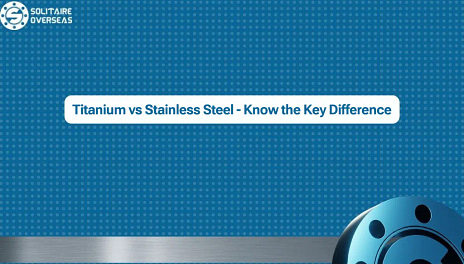The Difference between Titanium vs Stainless Steel

Titanium and stainless steel are renowned for their remarkable strength and resistance to corrosion, making them popular choices for various applications. However, the decision between these two metals can be complex due to factors such as cost and machinability.
In this article, we’ll explore the crucial distinctions between titanium and stainless steel to assist you and your team in making informed decisions for your machined parts and components.
What are the key differences between Titanium vs Stainless Steel?
Let’s organize the key differences between titanium and stainless steel for clarity:
1. Composition:
Titanium is an element, and its properties are naturally present in the metal.
Stainless steel is an alloy composed of iron, chromium, nickel, and other elements.
2. Versatility:
Stainless steel is more versatile due to its alloy nature, allowing for a broader range of applications and alterations in properties.
Titanium has more limited versatility compared to stainless steel.
3. Cost:
Titanium is generally more expensive than stainless steel, both as a raw material and for machining.
4. Strength in Temperature Fluctuations:
Titanium exhibits higher strength when exposed to temperature variations compared to stainless steel.
5. Medical Use:
Titanium is nontoxic and often used in medical applications, while stainless steel is also used in the medical field but may not have the same level of biocompatibility.
6. Hardness and Scratches:
Titanium is softer than stainless steel and is more prone to scratches.
7. Weight:
Stainless steel is heavier than titanium, making it a consideration for weight-sensitive applications.
8. Machinability:
Stainless steel is less expensive to machine compared to titanium.
9. Formability and Weldability:
Stainless steel is more formable and weldable than titanium, providing more options for shaping and joining.
10. Fatigue and Shattering:
Stainless steel is more subject to fatigue and shattering compared to titanium.
Machining and Using Titanium:
Machining precision parts with titanium poses unique challenges, primarily due to its high machining cost factor, which is approximately 30 times greater compared to most steel alloys. Despite these challenges, the benefits of using titanium are substantial. While the raw material cost is high and machining can be expensive, titanium offers a remarkable strength-to-weight ratio. Notably, titanium shares similar strength characteristics with stainless steel but is significantly lighter.
Key points about machining titanium include:
- Cost Considerations:
- Machining titanium is considerably more expensive than machining most steel alloys.
- Strength and Weight:
- Titanium provides comparable strength to stainless steel but at approximately 40% of its weight.
- Titanium is about 50% less dense than stainless steel.
- Aerospace and Medical Applications:
- Titanium parts are commonly used in the aerospace industry, where weight reduction is a critical priority.
- Titanium is favored for medical parts due to its biocompatibility.
Machining and Using Stainless Steel:
Stainless steel is a widely used metal in various industries, known for its exceptional strength and corrosion resistance. The presence of at least 10.5% Chromium is essential for stainless steel, granting it improved corrosion resistance. The versatility of stainless steel is evident in its numerous alloys, each tailored to specific purposes. Among these, the 300 grades of stainless steel are frequently employed for precision machined parts.
Key points about machining stainless steel include:
- Corrosion Resistance:
- Stainless steel is chosen for its excellent corrosion resistance, a feature attributed to the Chromium content in the alloy.
- Alloy Variety:
- Stainless steel encompasses a wide variety of alloys, each with unique properties designed for specific applications.
- Common Use in Precision Machining:
- The 300 grades of stainless steel are commonly used for precision machined parts across different industries.
Grades of Stainless Steel & Titanium
Grades of Stainless Steel & Applications
- Ferritic Stainless Steel:
- Composition: Contains 12-18% chromium; magnetic.
- Properties: Lower nickel content, making it cost-effective.
- Applications: Grades 409 and 430 are often used in exhaust systems and less visible parts requiring corrosion resistance.
- Martensitic Stainless Steel:
- Composition: Comparatively high carbon (up to 1.2%).
- Example: Alloy 410.
- Properties: Good corrosion resistance, heat treatable.
- Applications: Commonly used in blades, scissors, and medical tools.
- Austenitic Stainless Steel (300 Series):
- Composition: Contains 18% chromium and 8% nickel.
- Properties: Extremely corrosion-resistant.
- Applications: 300 Series stainless steel accounts for over 70% of worldwide production. Grade 304, in particular, holds 50% market share due to its economy, weldability, and high corrosion resistance.
- Specific Uses of Grade 304: Food service, exterior fixtures, high-wear areas, tubing, tanks, etc.
- Grade 316: Offers even higher corrosion resistance.
Grades of Titanium & Applications
- Commercially Pure (CP) Grades 1-2:
- CP Grade 1:
- Composition: Lowest oxygen and trace iron content.
- Properties: Soft and ductile.
- Applications: Used in pipe and tubing, as well as welded applications.
- CP Grade 2:
- Composition: Slightly higher tensile and yield strength than Grade 1.
- Properties: Affordable, higher strength.
- Applications: Commonly used in sheet form (0.04″), offering increased strength for applications like aerospace components.
- CP Grade 1:
- Commercially Pure (CP) Grades 3-4:
- CP Grade 3-4:
- Properties: Significantly stronger than CP Grades 1-2 but sacrifice some ductility.
- Applications: Weldable, durable; used in surgical equipment, high-value heat exchangers, chemical processing, and aerospace.
- CP Grade 3-4:
- Ti 6Al-4V (Grade 5):
- Composition: Alloy with 6% aluminum and around 4% vanadium.
- Properties: Most common titanium alloy, accounting for half of worldwide demand; increased temperature resistance; ultimate tensile strength nearly triples to 150 ksi.
- Applications: Widely used in aircraft components, engine and race car parts, marine applications, and wherever ultimate performance and weight reduction are critical.
Is titanium stronger than stainless steel?
Titanium surpasses stainless steel in terms of strength-to-weight ratio, making it particularly advantageous for high-stress applications such as airplane building and high-performance automobile designs.
While steel maintains overall superior strength, titanium’s strength per unit mass is notably higher. Titanium’s lightweight and robust characteristics make it a preferred choice where both strength and weight are critical factors.
In contrast, stainless steel, though not as strong as titanium, excels in corrosion resistance, making it a common choice for applications such as medical equipment and food processing where resistance to corrosion is paramount.
The selection between titanium and steel hinges on specific application requirements, with titanium often chosen for its exceptional strength and lightness.
Titanium vs. Stainless Steel: Which One is Right for Your Project?
Choosing the right metal for your project involves considering various factors, and both titanium and stainless steel present viable options for applications demanding high strength and durability.
Strength Requirements:
- If your project necessitates a high strength-to-weight ratio, titanium might be the ideal choice.
- For projects where moderate strength is sufficient, stainless steel could be a suitable alternative.
Corrosion Resistance:
- In environments exposed to harsh chemicals or saltwater, titanium stands out with superior corrosion resistance.
- For applications requiring moderate corrosion resistance, especially with specific grades like 316, stainless steel might suffice.
Weight Considerations:
- If weight reduction is critical, particularly in aerospace or automotive projects, titanium’s lower density provides notable weight savings.
- When weight is less of a concern, stainless steel remains a practical choice.
Thermal Properties:
- For projects demanding low thermal conductivity, titanium should be considered.
- If higher thermal conductivity is desired, stainless steel may be a better fit.
Fabrication and Machining:
- Stainless steel is generally easier to machine and fabricate, making it suitable for projects with specific requirements in these areas.
- If your project can accommodate the unique machining and fabrication needs of titanium, and other factors favor it, titanium becomes a viable option.
Cost:
- Stainless steel is often more cost-effective, making it a suitable choice for budget-sensitive projects.
- If the benefits of titanium justify a higher material and processing cost, it could be the right choice.
Biocompatibility:
- For projects in the medical or dental industry where biocompatibility is crucial, both titanium and certain stainless steel grades (e.g., 316L) are suitable, but titanium is often preferred.
Summary
The choice between titanium and steel hinges on various factors. Titanium’s higher strength-to-weight ratio makes it ideal for applications prioritizing weight reduction, while its superior corrosion resistance stands out in harsh environments. However, steel is generally more cost-effective, making it suitable for large-scale projects and cost-sensitive applications. Additionally, steel is easier to work with and machine, potentially reducing production costs. The decision ultimately depends on project-specific requirements, and by carefully considering factors such as cost, weight, strength, and corrosion resistance, you can make an informed choice that aligns with your application needs.
